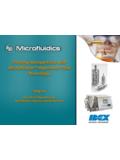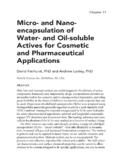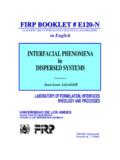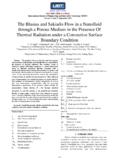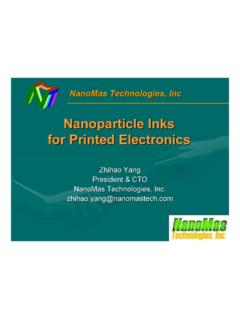Transcription of FSBI BRIEFING PAPER: NANOTECHNOLOGY IN …
1 FSBI BRIEFING paper : NANOTECHNOLOGYIN fisheries AND AQUACULTURER. D. Handy*School of Biomedical & Biological Sciences, University of Plymouth, Drake Circus, PlymouthPL4 8AA, SUMMARYN anotechnology involves the application of materials at the nanoscale to new prod-ucts or processes. It is a rapidly growing industry currently worth billions of , with many potential benefits to society. There are opportunities for thefisheries and aquaculture industries to use existing nanotechnologies, and also todevelop new applications specific to the industry. The potential benefits of nan-otechnology for fisheries and aquaculture need to be balanced against concerns forthe environment and the occupational health of workers. The key points are asfollows: Man-made nanomaterials (NMs), sometimes called engineered NMs or manu-factured NMs, are novel materials that have at least one dimension<100 nmor have a primary size in the 1 100 nm range.
2 These materials are producedin many different physical forms including nanoparticles (NPs), nanorods, nan-otubes, nanospheres and nanowires. The major chemical classes include metallicNPs, carbon-based NMs [carbon nanotubes (CNTs), carbon fullerene spheres] anda wide variety of composites made of more than one chemical substance. Thesurfaces of NMs can also be functionalised to create many different chemistries. Manufactured NMs are already used in consumer products and exposure modellingpredicts environmental concentrations of ng l 1to low gl 1levels of NMs insurface waters. The long-term impact of these predicted concentrations on fishesis currently unclear, and chronic effects on the environment cannot be excluded. NANOTECHNOLOGY is already being applied in the food industry. Applications forfisheries could include nanopolymers and coatings to strengthen food packagingin order to protect delicate fish fillets. The shelf life of fish and shellfish may beimproved with the use of antibacterial nanocoatings, and transparent polymer filmsthat can help exclude oxygen from around the food product.
3 Nanosensors on thefood packaging can also be used to report the deterioration of the fish or public engagement programme is needed to ensure public confidence in the fooduses of NANOTECHNOLOGY by the industry.*Author to whom correspondence should be addressed. Tel.:+44-(0)1752-584630; email: 2012 fisheries Society of the British Isles2 Fishes will eat food containing NMs and NANOTECHNOLOGY could be used to improvethe delivery of micronutrients or unstable ingredients in aquafeeds. For example,the use of nanoencapsulation technology for fat-soluble vitamins, minerals andfatty acids may be advantageous. Some NMs can change the physical properties( , hardness) of the feed. For fish health in aquaculture , nanotechnological applications include antibacterialsurfaces in the aquaculture system, nanodelivery of veterinary products in fish foodusing porous nanostructures, and nanosensors for detecting pathogens in the are many applications of NANOTECHNOLOGY in water purification for removingmicrobes, organic chemicals and metals.
4 From the view point of engineering, there are a plethora of new building materials,textiles and fabrics that could be used in aquaculture engineering and on fishingvessels. These include carbon nanofibres which are over 100 times stronger thansteel that could be used in cage construction, nets as well as mooring lines. Theantibacterial properties of NMs may be used to prevent biofouling on marinestructures. There is a considerable body of knowledge on the occupational health and safetyof NMs. Guidance notes are available for employers from various Governmentagencies, including the Health and Safety Executive in the The predictedoccupational health risks from NMs are probably low for fisheries workers, giventhat few staff would be using raw NMs or free particles. Guidance is available forsafe handling by scientific staff in research laboratories. The potential benefits of NANOTECHNOLOGY to fisheries and aquaculture industriesshould be balanced by the risks to the environment.
5 The colloidal behaviour of NPsis briefly outlined. Laboratory studies show that mg l 1levels of free NMs are toxicto some fish and invertebrates. Sub-lethal effects are noted at 100 gto1mgl 1of NMs and include many of the effects found with traditional chemicals such asrespiratory distress, gill injury, biochemical disturbances and effects on embryonicdevelopment. The ecotoxicity data so far suggest that manufactured NMs may haverelatively low toxicity compared to some traditional chemicals. However, there aremany data gaps, including a lack of data on the species important to aquacultureand fisheries . Measurement methods for the environmental monitoring of NMs and the surveil-lance of NMs in products, especially food such as fish fillets, are needed. The report concludes, on the basis of current evidence, that the benefits of usingnanotechnology in fisheries and aquaculture are considerable, and the potentialhazards should not stifle innovation, and the responsible use of NANOTECHNOLOGY inthese AND INTENDED AUDIENCEThe audience for this BRIEFING paper is the professionals working in the fisheriesand aquaculture industries.
6 The overall aim is to outline what NANOTECHNOLOGY andnanomaterials (NMs) are, and then go onto explain their potential applications in thefisheries and aquaculture industries. The document is intended as a practical guide 2012 fisheries Society of the British Isles3with some background on the chemistry of NMs and their biological effects onfishes, but the main focus will be on applications. These include considerationsfor new fish feeds, food packing/shelf life of fresh fish, materials for aquacul-ture engineering and fishing vessels, water quality technology and the delivery offish medicines. We also provide an overview of the health and safety considera-tions for NMs, both to protect the health of workers and the effects on IS NANOTECHNOLOGY AND WHAT IS THE INDUSTRYWORTH? NANOTECHNOLOGY involves the application of materials at the nanoscale to producenew products or processes, and with many potential benefits to society (Roco &Bainbridge, 2005).
7 The NANOTECHNOLOGY industry has grown rapidly. Initial estimates(NSF, 2001) predicted a global economic value of NANOTECHNOLOGY at around onetrillion dollars by about 2015, with a significant proportion on the theme ofsustainability, including food production and agriculture. These early predictionsmay have been over-optimistic, but nonetheless, the global investment in nanotech-nology was around 4 6 billion dollars by governments and 4 5 billion by commercial companies in 2005 (Lux, 2006). The growth of the indus-try is exemplified by over a thousand different products containing NMs in 2009( ), and estimatesof sales from NANOTECHNOLOGY worth around 1500 billion dollars in 2010 ( ). Clearly, the NANOTECHNOLOGY indus-try is an expanding market. The applications, risks and benefits have been discussedfor agriculture and food production, most notably in an initial report from theWoodrow Wilson International Centre for Scholars (Kuzma & VerHage, 2006), butthe current and potential applications of NANOTECHNOLOGY in fisheries or aquaculturehave not been ARE NANOMATERIALS?
8 Man-made NMs, sometimes called engineered NMs or manufactured NMs, arenovel materials with nanoscale dimensions. There are several definitions of NMs butit is generally agreed that they have at least one dimension<100 nm (Masciangioli &Zhang, 2003; Roco, 2003) or have a primary size in the 1 100 nm range (SCHENIR,2007). These materials have been produced in many different chemical forms, themain types including nanometals [ nanoparticles (NPs)], metal oxides ( ), carbon-based materials such as carbon nanotubes (CNTs) and carbonspheres ( , often called bucky balls by the media) as well ascomposites made of several substances such as nanoceramics and quantum dots(Boxallet al., 2007; Stoneet al., 2010). The latter can include combinations ofknown toxic metals, such as ZnS and CdSe, used in quantum dots for new light-emitting diodes (LEDs; Baeet al., 2009).However, there is the potential for infinite numbers of chemistries for NMs.
9 Itis possible to functionalise the surface of NMs with hydroxyl groups, carboxylicacid groups, sulphate residues,etc. The chemicals on the surface of the NM can becovalently bound, and essentially part of the structure of the material, or be a loosely 2012 fisheries Society of the British Isles4attached surface coating ( metal NPs). Second-generation NMsare now also emerging with complex three-dimensional shapes, and/or containingseveral different chemical substances. NMs are now being produced with highlyfunctionalized surfaces for very specific applications ( CNT). It isargued that the surface chemistry of the material is partly responsible for some ofthe physico-chemical properties at the nanoscale (see reviews, Handyet al., 2008a;Ju-Nam & Lead, 2008; Klaineet al., 2008) that will inform on product developmentand new can be made into many different shapes including nanofilms, nanowires,nanotubes and NPs, which can be spherical or rod-shaped (Nowack & Bucheli,2007).
10 Second-generation materials are now introducing new shapes, includingnanoneedles (high-aspect ratio crystals with sharp tips), and rosette-shaped carbonstructures. The primary size and shape of the material may not be the only consider-ation. For example, CNTs can be polymerized into carbon fibres that may be severalmm long and NPs may form aggregates or clusters that can be several hundred nmin diameter. Manufactured NMs can also be incorporated into products in many dif-ferent ways, such as surface coatings, laminates or as a material dispersed withinthe matrix of a product (Hansenet al., 2008). For example, nanosurface coatings onfabrics to make them water resistant, antibacterial nanolaminates on food packagingand the inclusion of NMs into the matrix of concrete to make it resistant to saltwatererosion. Numerous product applications have been suggested for NMs in electronics,fuel additives, building materials, textiles, paints, food, medical devices, bioremedi-ation, waste water treatment technology and personal care products (Aitkenet al.)

